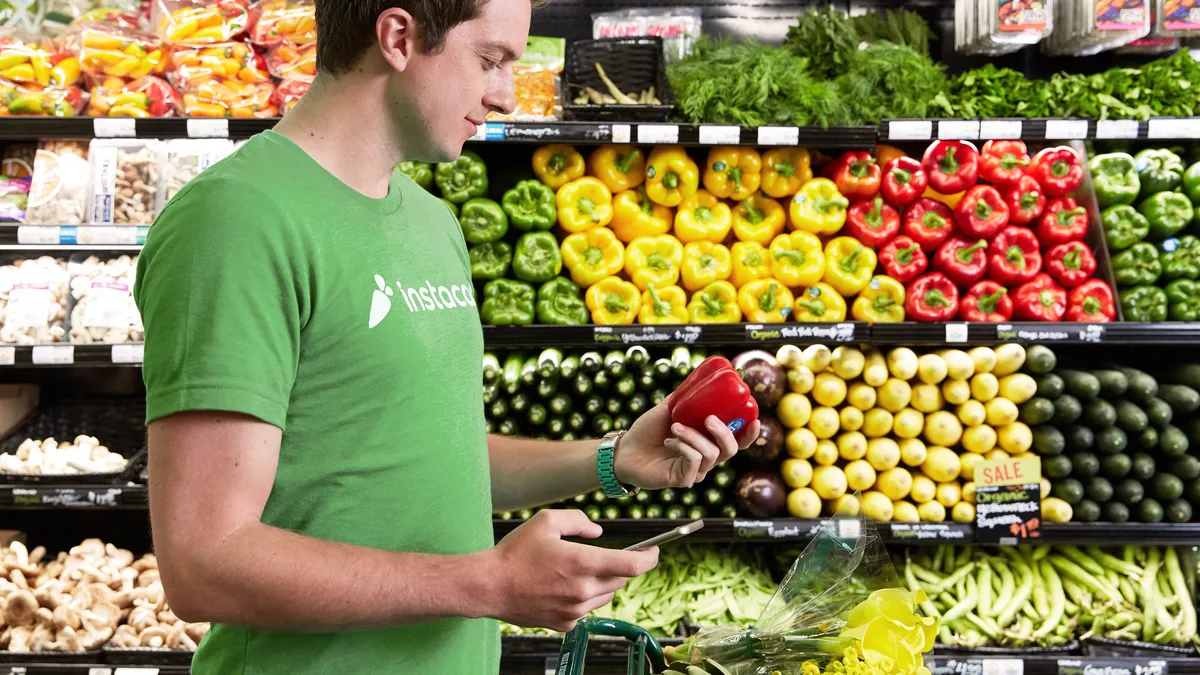Dive Brief:
- Prior to being acquired by Amazon in June, Whole Foods was not only one of Instacart’s early investors, but its largest customer at the time, accounting for almost 10% of the food delivery firm’s sales. The Amazon-Whole Foods deal had some industry pundits predicting the startup’s demise, but instead Instacart was busy racking up business with grocers across the country, reports Forbes.
- "It really was like a thermonuclear bomb against the entire grocery industry," Instacart CEO Apoorva Mehta told Forbes, commenting on the Amazon deal. "Every major grocery retailer in the country was calling us. When we look back, that may have been a turning point for Instacart."
- Instacart has inked deals with 165 retailers, most signing on just this year since the Amazon-Whole Foods merger. The delivery company’s roster reads like a who’s who among U.S. grocers, including chains such as Kroger, Costco, Publix, Stop & Shop, Wegmans and Aldi.
Dive Insight:
Amazon already had big plans to disrupt the grocery industry before the Whole Foods acquisition. The recently acquired natural and organic chain now provides the “one-two punch,” as research firm Packaged Facts recently called it, needed to propel the retail giant’s food and beverage sales.
In fact, Packaged Facts forecasts Amazon’s food and beverage sales could top $30 billion by 2025 with the projections based on it having a well-oiled omnichannel grocery strategy that marries its online and offline assets. It’s this kind of growth projection that puts tremendous pressure on competitive grocers. But don’t expect them to sit idly by while Amazon eats their lunch.
Grocery chains across the U.S. have been busy ramping up their own e-commerce offers in order to grab their fair share of what’s forecast to be a $100 billion online grocery opportunity by 2025. A large focus has been on developing click-and-collect models. But now to try and stay ahead of what could be an Amazon-Whole Foods maelstrom, a growing roster of retailers is looking at home delivery too.
Many have recently inked deals with home delivery companies — Instacart, Shipt, Uber Delivery, among others — to support their “last mile” strategies. It turns out that Instacart could be one of the biggest beneficiaries of the Amazon-Whole Foods deal. The upstart delivery service has expanded from 30 markets at the beginning of 2017 to over 150 today, blowing by growth projections en route to attaining a goal of reaching 80% of U.S. households by 2018.
“The acquisition was a wake-up call to all grocers that having an e-commerce strategy is critical, and we knew that would be an incredible opportunity for us,” Mehta wrote in an email to Food Dive. “In the wake of that announcement, we’ve launched or expanded many key partnerships and continue to have strong momentum with many top grocers.”
Forging all of these partnerships with different grocers seems to increase the likelihood that Instacart will remain a standalone entity rather than getting purchased by a big player, like Peapod was by Ahold in 2001. Peapod — in hindsight, a concept ahead of its time — emerged as the sole survivor of the online grocery collapse nearly two decades ago.
Other grocery delivery companies of the dotcom era, including now long-defunct Webvan and Kozmo, flamed out quickly, in part because of their rapid-fire growth during a time when U.S. consumers weren't quite ready for online grocery shopping. Also, promising one-hour or even half-hour delivery service, much of the time for free, didn't help the model.
But nowadays, shoppers increasingly demand the convenience of ordering groceries online: 30% of digital shoppers say they spend about a quarter of their food budget online. This percentage is expected to more than double in the next 10 years, with 72% of shoppers projected to conduct 25% of their grocery shopping online by 2025. Instacart clearly is taking full advantage, positioning itself for this kind of explosive growth ahead.








